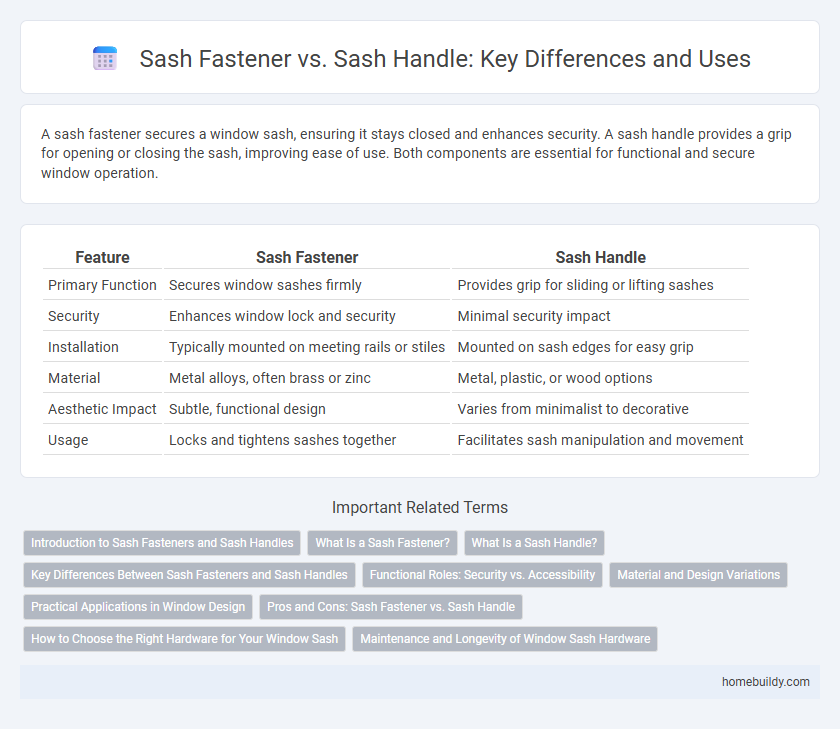A sash fastener secures a window sash, ensuring it stays closed and enhances security. A sash handle provides a grip for opening or closing the sash, improving ease of use. Both components are essential for functional and secure window operation.
Table of Comparison
| Feature | Sash Fastener | Sash Handle |
|---|---|---|
| Primary Function | Secures window sashes firmly | Provides grip for sliding or lifting sashes |
| Security | Enhances window lock and security | Minimal security impact |
| Installation | Typically mounted on meeting rails or stiles | Mounted on sash edges for easy grip |
| Material | Metal alloys, often brass or zinc | Metal, plastic, or wood options |
| Aesthetic Impact | Subtle, functional design | Varies from minimalist to decorative |
| Usage | Locks and tightens sashes together | Facilitates sash manipulation and movement |
Introduction to Sash Fasteners and Sash Handles
Sash fasteners secure window sashes by locking them in place, enhancing security and weather resistance, while sash handles provide a grip point for easy opening and closing. Sash fasteners typically include locking mechanisms that prevent sash movement, whereas sash handles focus on ergonomic design and usability. Understanding the distinct roles of sash fasteners and handles is essential for selecting functional and secure window hardware.
What Is a Sash Fastener?
A sash fastener is a hardware component designed to secure window sashes by locking them tightly in place, ensuring enhanced safety and improved insulation. Unlike a sash handle, which primarily serves as a grip to open or close the window, a sash fastener provides a locking mechanism that prevents sash movement and improves energy efficiency. Sash fasteners are essential for maintaining window stability and security in both traditional and modern window designs.
What Is a Sash Handle?
A sash handle is a hardware component attached to the window sash, designed for easy gripping and sliding of the window. Unlike a sash fastener, which secures the window by locking the sash in place, the sash handle primarily facilitates opening and closing movements. It enhances user convenience by providing a sturdy grip without the locking function inherent to sash fasteners.
Key Differences Between Sash Fasteners and Sash Handles
Sash fasteners serve as locking mechanisms that securely hold window sashes in place, enhancing security and weather sealing, whereas sash handles primarily provide a grip point for easy sliding or lifting of the window sash. Fasteners often incorporate locking features such as latches or bolts, while handles focus on ergonomic design for user comfort during operation. Understanding these distinctions is essential for selecting the appropriate hardware based on security needs versus ease of use in window functionality.
Functional Roles: Security vs. Accessibility
Window sash fasteners primarily provide security by locking the sash firmly in place, preventing unauthorized opening and enhancing safety. Sash handles focus on accessibility, offering an easy grip for smoothly sliding or lifting the window sash during operation. While fasteners secure the window, handles facilitate effortless movement, both essential for optimal window functionality and user convenience.
Material and Design Variations
Sash fasteners are typically crafted from durable metals such as brass, stainless steel, or zinc alloy, ensuring secure locking and corrosion resistance for enhanced window security. Sash handles, however, often feature a wider range of materials including wood, plastic, and metal, focusing more on ergonomic design and aesthetic appeal for comfortable grip and style integration. Design variations in fasteners emphasize functionality and strength with compact, low-profile shapes, while handles prioritize user interaction with larger, shaped forms to facilitate ease of use.
Practical Applications in Window Design
Sash fasteners provide secure locking mechanisms that enhance window safety and weatherproofing, making them ideal for functional and secure window designs. Sash handles primarily assist in ease of operation and aesthetic appeal, facilitating smooth sash movement without significantly impacting security. Selecting between a sash fastener and sash handle depends on the balance of security requirements versus ease of use in residential or commercial window installations.
Pros and Cons: Sash Fastener vs. Sash Handle
A sash fastener provides enhanced security by firmly locking window sashes together, reducing drafts and improving energy efficiency, while a sash handle primarily offers ease of opening and closing without significant locking capability. Sash fasteners are typically more durable and tamper-resistant but may require more effort to operate compared to sash handles, which are convenient for quick access but offer limited protection. Choosing between the two depends on prioritizing security and insulation versus accessibility and user convenience.
How to Choose the Right Hardware for Your Window Sash
Selecting the right hardware for your window sash involves understanding the functional differences between sash fasteners and sash handles. Sash fasteners secure the window in place, enhancing safety and energy efficiency, while sash handles primarily facilitate easy operation and opening. Prioritize durable materials like stainless steel or brass and consider compatibility with your window type to ensure optimal performance and longevity.
Maintenance and Longevity of Window Sash Hardware
Sash fasteners typically require less maintenance than sash handles due to their simpler mechanism and fewer moving parts, reducing wear over time. Proper lubrication and regular inspection of sash fasteners extend the lifespan of window sash hardware by preventing corrosion and ensuring smooth operation. In contrast, sash handles, often exposed to more frequent manual use, may experience quicker wear and require more frequent replacements to maintain window security and functionality.
Sash fastener vs Sash handle Infographic

 homebuildy.com
homebuildy.com